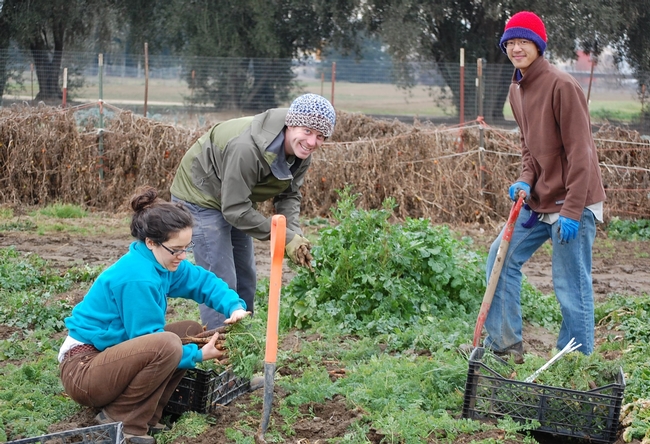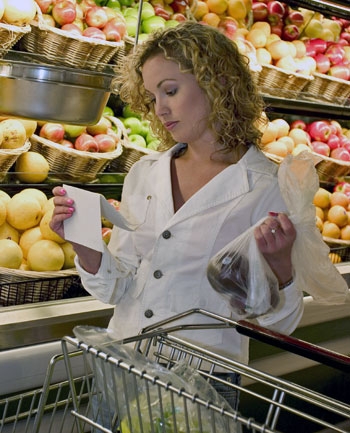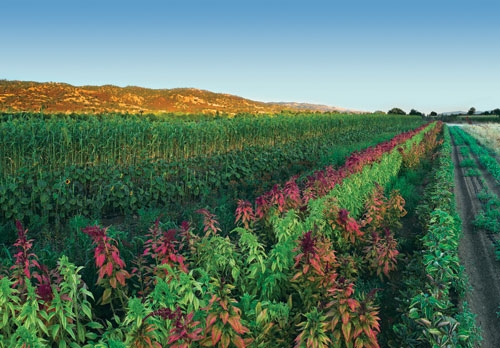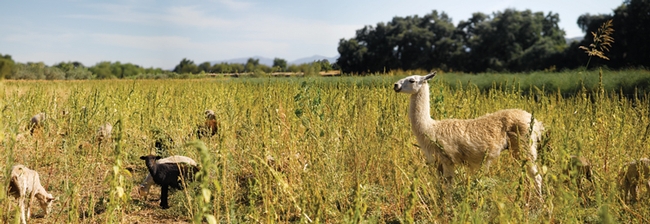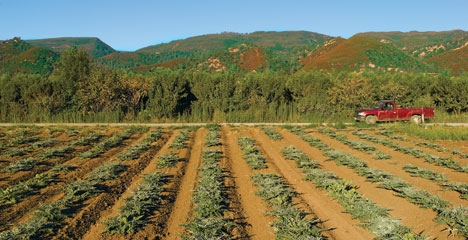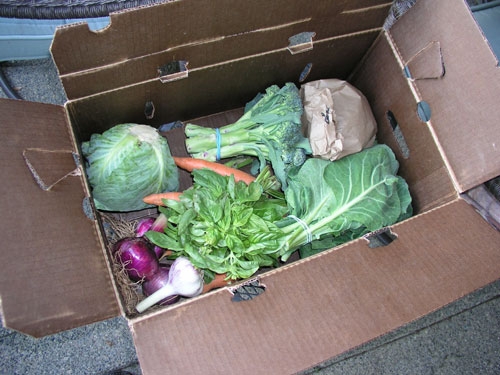UC Food Blog
More young people see future in farming
The USDA is gearing up for the 2012 Census of Agriculture, the complete count it makes every five years of U.S. farms and ranches and the people who operate them. The agricultural census provides a fascinating look at farming demographics: How old are they? Where do they live? What do they grow?
Most experts believe the census will show a trend towards the green – not just green as in sustainable, local and small-scale - but also green as in greenhorn. It seems more people from non-farming families are seeking farming careers. (You can read an Associated Press story on the topic here.)
That is especially good news in California, where the current average age of a farmer is nearly 60. Farming is a $37.5 billion business in California employing 800,000 people and providing 12 percent of the nation’s agricultural exports. With the world population forecast to grow from 7 billion to 9 billion by 2050, the demand for California’s food production will continue to grow.
Will California’s farmers be able to meet that need? The UC Davis Department of Plant Sciences is helping by providing cutting-edge research and educating a whole new crop of young people eager to take on the back-breaking work of farming the land.
“We’re definitely seeing an increased interest in farming among students,” says Crop Physiology Professor Ted DeJong, a faculty adviser for the department’s Horticultural and Agronomy Graduate Group, a popular major for students interested in farming and other aspects of agriculture. Indeed, student enrollment in horticulture and agronomy has increased from 53 in fall 2008 to 92 in fall 2011.
“Yes, I do think more young people are interested in farming,” said Gina Garland, who received her master's degree in horticultural and agronomy from UC Davis last spring. “Food is so important and it’s not very secure right now, with climate change and all. Many of us are interested in trying to find ways to make farming work in our changing environment.”
Garland is now working with AmeriCorps and a non-profit group in Albuquerque, N.M., farming and helping others farm. She might not become a farmer herself, choosing, perhaps, to seek a Ph.D. (hopefully, she says, at UC Davis), conducting research to help others farm more profitably and sustainably.
Meanwhile, at the UC Davis Agriculture Sustainability Institute Student Farm, young people are hoeing weeds, harvesting carrots and learning the joys and challenges of farming.
“It’s good to know where your food comes from,” says Eric Lynn, and undergraduate plant sciences student. “I think that’s what attracts a lot of us to farming.”
The high cost of farmland in California makes it tough for young people to enter the business, as noted in this recent story in the Western Farm Press. But many are finding ways to make farming pay by producing vegetables for sale at local restaurants, for example, or marketing their produce online. From urban roof-top gardening to using the latest in conservation agricultural practice, a new, younger breed of farmer is heeding the call. You can read more about that in this recent story on sfgate.com.
Also, have you heard about the Center for Land-Based Learning? Located in Winters, just west of campus, this non-profit is dedicated to creating the next generation of farmers and teaching California’s youth about the importance of agriculture and watershed conservation. You can learn more at: http://landbasedlearning.org/
Plan, shop, save and cook
To meet the needs of today’s time-pressed consumers, UC Cooperative Extension nutrition, family and consumer sciences advisors collected the most pertinent food budgeting and healthy eating concepts together in a new curriculum that can be presented in four one-hour sessions. The curriculum is taught by UC CalFresh, a nutrition education program that helps recipients of federal food assistance (formerly called Food Stamps) make the most of their benefits.
Typically, participants are offered an eight-session course called “Eating Smart Being Active.” The UC advisors realized the audience couldn’t always devote that much time to nutrition education, said Marisa Neelon, nutrition, family and consumer sciences advisor in Contra Costa County. The salient parts were extracted and compiled into four content-packed interactive lessons: Plan, Shop, Save and Cook.
Plan, Shop, Save and Cook is presented by UC CalFresh nutrition educators at schools, churches, shelters and other venues where at least 50 percent of the participants are eligible based on federal income guidelines. But anyone can benefit from the straight-forward, simple guidelines set forth in the curriculum. Below is a sampling:
Plan
Planning meals ahead saves time and money. Families save time by avoiding last-minute trips to the grocery store. They save money by taking advantage of the weekly specials and coupons that are published in the store circulars.
Before sitting down to plan a week of meals, check the refrigerator, freezer, cupboards and pantry for foods to use. Review the store’s weekly ad for foods you need and to see what vegetables and fruits are in season. In-season produce usually costs less and tastes better.
Build your meals around low-cost, healthful food items, such as:
- Protein - beans (garbanzo, black, cannellini), tofu, nuts, chicken and eggs
- Vegetables - carrots, potatoes, lettuce and leafy greens
- Fruit - apples, bananas , oranges and grapes
- Grains - brown rice, whole wheat bread, oatmeal and pasta
- Dairy - calcium fortified soy milk, milk, reduced or low fat cheese
Using the meal plan and grocery store ad, make a detailed shopping list.
Shop
At the grocery store spend time carefully reading food labels, especially the “nutrition facts” and “ingredients.”
Consider the serving size on the label, how many calories and fat are in one “serving” of food and whether that serving would be a typical portion for you and your family.
The ingredient list is also important. The ingredients are listed in descending order of predominance by weight. In other words, the ingredient that weighs the most is first, and the ingredient that weighs the least is last.
Save
When comparing prices, look for the unit price on the shelf sticker. The unit price, typically found next to the price of the product, gives the item’s cost per pound, gallon, ounce, etc. You will be able to see whether purchasing a large quantity really does cost less.
Stick to your shopping list, but be flexible. Stores will often have unadvertised specials that you can work into your healthy menu. However, avoid buying “extras” like chips and soft drinks. The cost adds up fast.
If possible, shop without children. Children may ask their parents to buy things that are not on the grocery list, not particularly healthy and often expensive. Children can also be distracting when trying to make calculations and keeping track of purchases.
If you must bring the kids, allow for extra time and involve them in the shopping process. Young children can count produce and put it into a bag. Older children can help search for specific foods, read labels and calculate unit pricing.
Cook
Use the food you purchased and the menu you planned to put together low-cost, healthy meals, such as:
- Rice and beans
- Baked chicken, potatoes and a vegetable
- Pasta and a salad
- Scrambled eggs with vegetables and toast
If your evenings are busy, keep a collection of quick recipes with minimal ingredients, find a time when you can cook several meals in advance or cook extra and plan to use leftovers for another meal.
To request a presentation of Plan, Shop, Save and Cook by UC CalFresh to an eligible group, contact your county UC Cooperative Extension office.
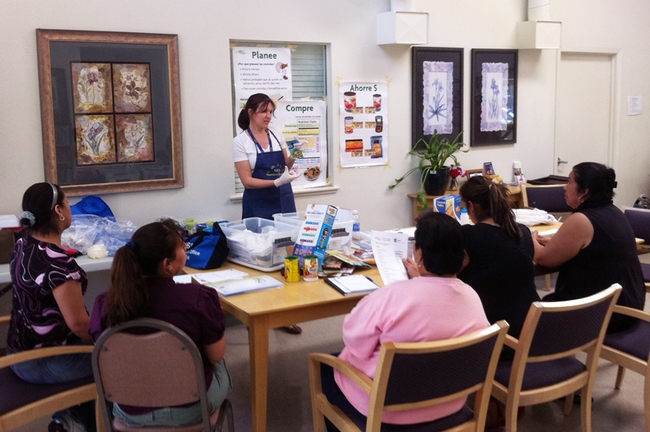
A UC CalFresh nutrition educator presents the Plan, Shop, Save and Cook curriculum.
Feed big; start small
Adapted from an article by Eileen Ecklund in Breakthroughs magazine.
But a group of UC Berkeley scientists say that continuing on our current path of industrial agriculture is simply not sustainable, given its enormous water, energy and chemical inputs, together with the new challenges posed by climate change, such as temperature and precipitation extremes.
With the launch of the interdisciplinary Berkeley Center Diversified Farming Systems late last year, UC Berkeley scientists are coalescing around a set of biodiversity-promoting farming practices they say are a promising solution.
Claire Kremen, a conservation biologist and associate professor in the Department of Environmental Science, Policy and Management, says that most or even all of the inputs that modern commercial farms require — chemical pesticides and fertilizers, wasteful amounts of water and energy, imported pollinators — were needed only because the monoculture-dominated landscapes created by industrial agriculture lacked biodiversity.
"From studying the pollinators, I realized that the way we conduct agriculture has basically required us to replace all of the ecosystem services that used to be in the agricultural ecosystem with substitutes," said Kremen, a 2007 MacArthur Fellow.
Generally speaking, a diversified farming system is one that promotes biodiversity across spatial scales, from plot to field to landscape. Crops are planted and livestock raised in combination, resulting in interactions that sponsor the functioning of the farming systems in ways that replenish natural ecosystems. Methods employed within a diversified farm may include minimal soil tillage, growing multiple crops together, planting cover crops, and interspersing trees and shrubs with crops and livestock.
These practices also provide pollination, pest and disease control, water purification, and erosion control. They help to build healthy, productive soil and reduce water use, as demonstrated by research conducted by Kremen and her Berkeley colleague Miguel Altieri in their respective labs and on farms in Napa, Sonoma, and Yolo counties.
But diversified farming systems aren't just about providing food and protecting the environment; to be truly sustainable, they must also provide a livelihood to farmers and farm laborers, and help support the communities that depend on them. UC Berkeley-based Cooperative Extension specialist Christy Getz has studied farm labor conditions and food security among agricultural workers. In one project, her team developed a program to help Southeast Asian refugee farmers in California scale up their operations, connect to alternative distribution systems, and access new markets for their produce, such as local schools.
Professor Alistair Isles focuses on the public policy, science policy, and sociological dimensions of making a switch back to diversified systems from industrial agriculture in developed countries. For example, he has studied the importance of innovative consumer tools that promote sustainable agriculture such issues as "food miles"—the distance that food travels from farm to table—and sustainable seafood evaluation methods.
If farmers could bring back many of the traditional practices that supported biodiversity, enhanced by the application of modern ecological science, Kremen believes that the world could produce more food while reducing agriculture's harmful effects, making it more sustainable over the long term.
And unlike organic agriculture, diversified farming systems are not an all-or-nothing approach; Kremen says farmers can implements all the systems the Berkeley center recommends based on its research, or simply implement selected techniques, such as planting native-plant hedgerows or using soil-enriching cover crops, and still make their farms more sustainable.
Community supported agriculture prospering in Central Valley
Community Supported Agriculture (CSA) – a way of buying fresh produce and other foods directly from farmers – is growing rapidly in California’s Central Valley, according to a newly published study in the California Agriculture journal.
Membership in the CSAs surveyed for the study increased from an estimated 672 in 1990 to 32,938 in 2010.
The growth in Central Valley CSAs is one part of a bigger movement toward stronger direct relationships between farmers and consumers, said Ryan Galt, UC Davis assistant professor in the Department of Human and Community Development and co-author of the study “Community Supported Agriculture is thriving in the Central Valley."
“Consumers increasingly want to connect with the farmers who grow their food,” Galt explained, while unpacking a cornucopia of vegetables from his own CSA box. “Food is an intimate thing, so I don’t think it’s strange that people want to establish relationships with those who produce it.”
While Galt’s study focuses on the farm, rather than consumer, side of the relationship, he said he joined a CSA for several reasons.
“I wanted to support a more ecologically oriented agriculture, and the livelihoods of farmers and farmworkers. And then, there is the benefit of not having to shop as much,” he added, snipping a bunch of deep purple beets from their greens.
It’s beet season in California. The dark root vegetable is relatively new to Galt’s culinary repertoire. Had it not shown up in the first CSA box to which he subscribed, years ago, he might never have learned to prepare it and would unlikely order it on a menu. The surprise and challenge of preparing new, interesting foods is among the reasons Galt still subscribes to a CSA.
Like most California CSA members, Galt picks up a basket of produce from a central location, not necessarily the farm itself. Some CSA farms deliver directly to homes. Few require members to visit the farm, but most host member events.
“CSA farmers provide their members more than food. They offer a direct connection to what is happening on the farm and with the seasons, they educate their members on agricultural and rural issues, and they share recipes that help members use their food,” Galt said, sliding a pot of beets into the oven.
It’s a lucrative exchange for CSA farmers, he adds. Average gross sales per acre for CSA farms is six times greater than average CA farms. Because people subscribe to their farm in the same way people subscribe to magazines, CSA farmers have a good idea how much to produce and harvest, and, most importantly for them, they have a promised market and up-front cash. Many young farmers are creating CSAs because of these benefits.
“CSA farmers are motivated by their love of farming and the satisfaction of providing fresh produce to grateful members,” Galt said.
Roasted beets
6 medium beets
2 tablespoons balsamic vinegar
2 teaspoons orange zest
Pepper
Preheat oven to 350 F. Wash the beets and put the unpeeled in a roasting pan with about an inch of water. Cover and bake for an hour, or until they are easily pierced with a folk. Slip off the skins after the beets have cooled. Slice the beets into wedges. Toss with vinegar, orange zest and pepper. Serve at room temperature.
Can smartphones help us eat smarter?
Nowadays, there are apps on our mobile devices that will do virtually anything. They help us get organized, give us the news, entertain us, help us plan trips and allow us to connect with friends. One thing that has become apparent as I peruse the online app store for my latest download is that there are many, many apps devoted to food, nutrition, health and most importantly - weight loss. The apps count calories, suggest healthier foods, encourage exercise, plan meals and provide useful grocery shopping tips. With boundless technology literally at our fingertips, I wonder if apps can actually help the average smartphone-wielding consumer make smarter, healthier eating decisions.
What does the research show?
Students at Cornell University took part in a study where they were given a mobile phone app and asked to take photos of anything they do or don’t do that might be considered good (such as taking the stairs) or bad for them (such as making a late-night fast food run). They uploaded these photos into the mobile app then rated them based on their healthfulness. They were asked to do this at least five times a day. They could all review their previous posts and a portion of the participants could view posts uploaded by their peers. Most participants reported increased health awareness and self-control at the end of the study, particularly among the group that could see photos taken by their peers. The study was only two weeks long, and didn’t lead to any real behavior change, but the researchers believe there is potential for more significant change after long-term use of the app.
Taking matters into my own hands…
Armed with a smartphone and some reusable shopping bags, I set out to my local grocery store to conduct a food shopping experiment of my own. Prior to going to the grocery store, I downloaded a few free apps onto my iPhone that I thought would be useful on this shopping expedition.
Since saving money on groceries is high on my list of priorities, I downloaded the Food on the Table app, which claims to be a better way to plan meals and save money. After filling out a short profile, the app helped me plan a meal, organize a grocery list and take advantage of in-store coupons within minutes. I chose to make the butternut squash and black bean enchiladas recipe, and navigated the grocery store with my cell phone in-hand to find all of the necessary ingredients. As I perused the tortilla display, I made use of another app that I downloaded, the Shop Well app, to help me choose the healthiest option among the multitude of tortillas available in the grocery store. With this app I could scan barcodes of the various tortillas and was given a personalized food score of each product based on a profile I filled out earlier (listing my health goals and any medical conditions). One package of tortillas turned up as a “medium” match for me. The app suggested another type of tortilla that would be a better match for my goals. Meanwhile, the Food on the Table app was telling me about a brand of tortillas that was on sale on that particular day. Of course they weren’t the same, so I opted for the healthier product over the on-sale product because the difference in price was marginal.
Next, I went home and prepared the meal following the directions on the app. After preparing the meal, I served up my plate of food and took a picture to upload into the Pic Healthy Photo Food Diary app. With this tool, I could upload my photo and rate how healthy (or unhealthy) my meal was, and let friends also be the judge (see pic on right). The idea is that friends can either cheer me on for making a healthy decision or call me out for a not-so-healthy meal choice. I’m still waiting for someone to rate my meal, but I can see how this could be fun and motivational if my friends were also participating, and we were all encouraging one another to reach our health and wellness goals.
I then used the Lose It! app to keep track of what I was going to eat and to determine the amount of calories in my meal. I entered every ingredient into the recipe section and came up with a calorie count and nutrient breakdown for the meal I was about to consume. Granted, it was a little tedious, but a great process that made me really think about what I was about to eat. If I continue to use this app, I will certainly think twice the next time I chow down on a big meal or snack.
The meal I chose to make ended up being far too spicy for my taste (if only the app rated the meal based on heat!). Despite this unfortunate setback, the process was educational – and dare I say FUN? It’s unlikely that I will go back to the grocery store and use my phone to scan products to identify healthy options (it’s far easier to use basic nutrition know-how to make these decisions – make half your grains whole, choose foods low in saturated fat, eat more fruits and vegetables, etc., etc). But I definitely enjoyed the menu planning app and appreciated being able to have new recipe ideas at my fingertips (even if my first choice was a bit of a disappointment!).
If you’ve made it a goal to eat healthier, exercise more and possibly lose weight in the New Year, then why not give one of the many mobile apps a try. Even better, get your friends and family involved and download apps together that allow you to motivate one another to stick to your goals. With all this technology at your fingertips, eating smarter may have just gotten a little easier!



